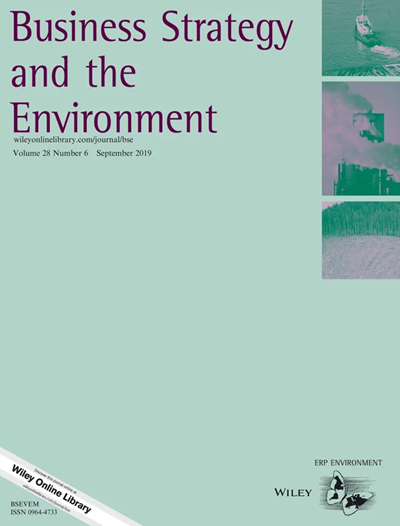知识和创新能力如何推动环境创新?来自跨国公司的证据
IF 13.3
1区 管理学
Q1 BUSINESS
引用次数: 0
摘要
本文分析了2013 - 2023年36个国家4416家企业的知识和创新能力对企业环境创新的影响。研究结果表明,一个国家的知识和技术创造产出对环境创新有重大贡献。然而,随着关注焦点从内部知识和技术创造转向外部知识和技术传播,这种关系发生了变化。虽然国家知识和技术影响产出也在较小程度上促进了创新,但知识和技术的扩散并不是统一地促进了企业环境创新。我们认为,这种关系表明存在类似反弹效应的特征,这表明企业不应该假设知识传播增加与环境创新成果之间存在线性或一致的正相关关系。此外,这种关系是与收入相关的。此外,正在进行可再生能源项目和环境投资的企业取得了显著更好的环境创新绩效。可持续发展和与ESG相关的高管薪酬对环境创新有相当大的积极影响。国家层面的能源强度是进展的重大障碍,而企业层面的生物多样性披露则促进了能源强度。本文章由计算机程序翻译,如有差异,请以英文原文为准。
How Knowledge and Innovation Capabilities Drive Environmental Innovation? Evidence From Global Firms
This paper analyses the impact of knowledge and innovation capabilities on firm‐level environmental innovation in 4416 firms across 36 countries from 2013 to 2023. The findings suggest that a national output of knowledge and technology creation makes a significant contribution to environmental innovation. However, this relationship changes as the focus shifts from internal knowledge and technology creation to external knowledge and technology dissemination. While the national knowledge and technology impact output also enhances innovation to a lesser degree, the diffusion of knowledge and technology does not uniformly improve corporate environmental innovation. We suggest that this relationship suggests the existence of a rebound effect‐like character, indicating that firms should not assume a linear or uniformly positive relationship between increased knowledge dissemination and environmental innovation outcomes. Additionally, the relationships are income‐specific. Furthermore, firms with ongoing renewable energy projects and environmental investments achieve significantly better environmental innovation performance. Sustainability and ESG‐related executive compensation have a considerable positive impact on environmental innovation. Country‐level energy intensity acts as a significant barrier to progress, whereas firm‐level biodiversity disclosure enhances energy intensity.
求助全文
通过发布文献求助,成功后即可免费获取论文全文。
去求助
来源期刊

Business Strategy and The Environment
Multiple-
CiteScore
22.50
自引率
19.40%
发文量
336
期刊介绍:
Business Strategy and the Environment (BSE) is a leading academic journal focused on business strategies for improving the natural environment. It publishes peer-reviewed research on various topics such as systems and standards, environmental performance, disclosure, eco-innovation, corporate environmental management tools, organizations and management, supply chains, circular economy, governance, green finance, industry sectors, and responses to climate change and other contemporary environmental issues. The journal aims to provide original contributions that enhance the understanding of sustainability in business. Its target audience includes academics, practitioners, business managers, and consultants. However, BSE does not accept papers on corporate social responsibility (CSR), as this topic is covered by its sibling journal Corporate Social Responsibility and Environmental Management. The journal is indexed in several databases and collections such as ABI/INFORM Collection, Agricultural & Environmental Science Database, BIOBASE, Emerald Management Reviews, GeoArchive, Environment Index, GEOBASE, INSPEC, Technology Collection, and Web of Science.
 求助内容:
求助内容: 应助结果提醒方式:
应助结果提醒方式:


